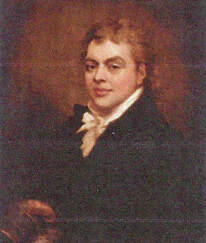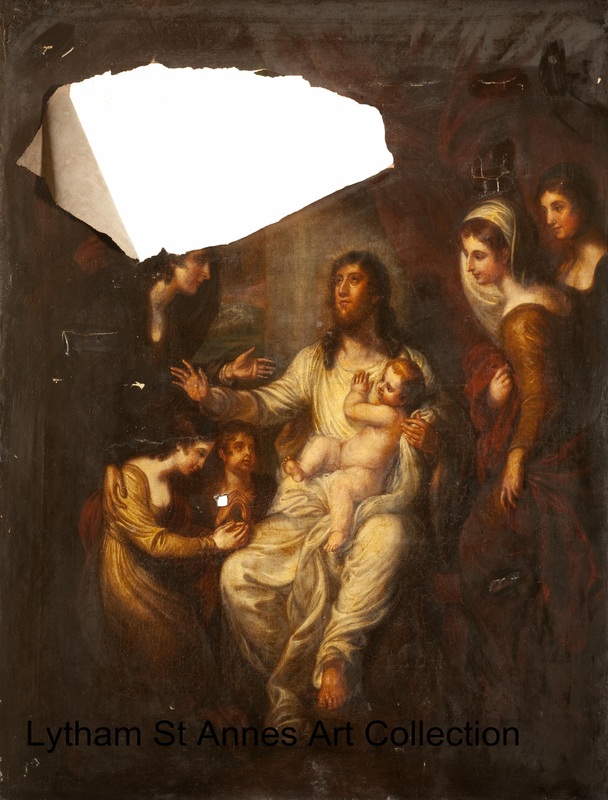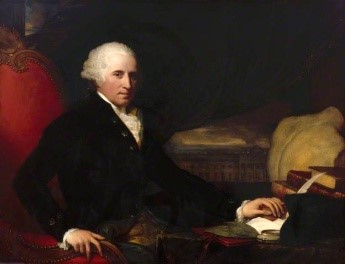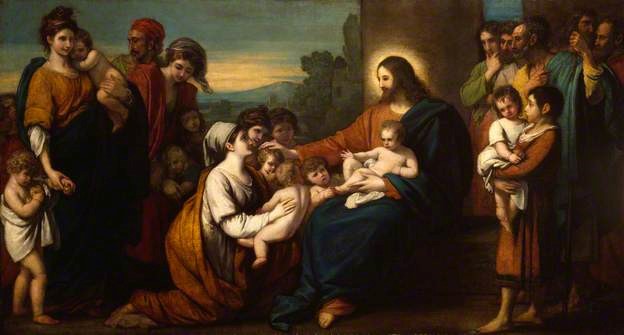Christ Blessing the Little Children
|
Research by Marjorie Gregson
|
|
Acc No 179
Artist Mather Brown, 1761-1831 (follower of Benjamin West 1738-1820) Medium oil on canvas Size 119.4 x 99.1 cm (47 x 39 in) Date painted unknown Donor Henry Randle Heys, 1916-1951 Westfield, 14 Clifton Drive, Lytham Date donated 29 July 1946 Also donated by Henry Randle Heys: The Watering Place by William Shayer Mother and Child by Sir Thomas Lawrence (unlocated) |
 Mather Brown (1761-1831) Mather Brown (1761-1831)
ARTIST
The Public Catalogue Foundation have attributed this painting to William West but Fylde Council have been advised by Christies that the work should be attributed to a follower of Benjamin West (1738-1820), second President of the Royal Academy. If William West was the artist, as has been suggested, it is unlike the subjects with which he was associated. It is indeed more likely to have been painted by a follower of Benjamin West, who was an acknowledged artist of Biblical scenes and had painted the very same subject. Indeed, when the painting was accepted into the Collection by the Lancashire Museums Service, the artist was named as Mather Brown (1761-1831), who was born in Boston, Massachusetts, the son of Gawen, a clockmaker, and Elizabeth (Byes) Brown and descended from several New England divines. He was brought up by two maternal aunts until around 1773 when he became a pupil of Gilbert Stuart. At 16 he walked to New York to sell wine and miniature portraits which allowed him to fund his artistic studies. He arrived in London in 1781 to further his training in Benjamin West's studio and a year later became the first American to enrol in the school of the Royal Academy of Art. In 1784 he painted two religious paintings for the church of St Mary's-in-the-Strand which led him into a commercial partnership with the painter, Daniel Orme, regarding both these and other works, through exhibitions and the sale of engravings. He also opened his own studio. Brown painted large scale works from English history before concentrating on portraiture, his first successes being with American sitters. His subjects included John Adams and his family and one of the earliest known portraits of Thomas Jefferson, who was visiting London. His 1788 full-length portrait of Prince Frederick Augustus in the uniform of Colonel of the Coldstream Guards led to his appointment as History and Portrait Painter to the Prince, later the Duke of York and Albany. Other paintings include the Prince of Wales, later George IV and Queen Charlotte. A falling off of patronage in the mid-1790s, and failure to be elected to the Royal Academy, led Brown to leave London in 1808 for Bath, Bristol and Liverpool. In 1812, when he painted this self portrait for his aunts, he was badly in debt and they periodically sent him money. He settled in Manchester, returning to London almost two decades later. In 1824, even after West's death, he continued to imitate his teacher's style of painting. Unable to secure commissions, Brown eventually died in poverty in a boarding house in London, all but forgotten. Today, his work is once again appreciated and found in many galleries. Benjamin West Benjamin West was born in 1738 in Springfield, Pennsylvania. An American history and portrait painter, and close friend of Benjamin Franklin, he spent almost all his career in England. After early success as a portrait painter in New York, he studied in Italy from 1760-63 before settling in England. His painting, Death of Wolfe, was a popular and critical success and was exhibited at the Royal Academy in 1771, where he was a founder member. George III appointed West his official history painter in 1772 with an annual fee of £1000. He painted nine portraits of members of the royal family, including two of the king.
In addition he painted a series of large canvases showing scenes from the life of Edward III for St George’s Hall in Windsor Castle and painted twenty-eight works on 'the progress of revealed religion' for a chapel in the castle. A prolific artist, he became known for his large scale history paintings; he produced the Death of Nelson in 1806 to commemorate Nelson’s death at the Battle of Trafalgar. West was also renowned for his religious paintings. Christ Healing the Sick was originally intended for a Quaker Hospital in Philadelphia but instead he sold it to the British Institution for £3000, which in turn presented it to the National Gallery. Its success led him to paint even larger works, including Death on a Pale Horse, exhibited in 1817. Other paintings include Archangel Michael Binding the Devil (Trinity College, Cambridge) and Moses receiving the law on Mount Sinai (Parliamentary Art Collection) He died in London in 1820. William West
William West was an English landscape painter in oils and watercolours. He was a member of the Bristol School of Art and a member of the Society of British Artists. West arrived in Bristol around 1823 and started exhibiting there. From 1824 he participated in the sketching activities of the Bristol School and during the same year exhibited at the Royal Academy and the British Institution. After 1826 he did not exhibit at these two institutions again until 1845. From 1847 he concentrated on Norwegian subjects and became known as 'Norway West' or 'Waterfall West' because of his fondness for location and subject. Two of his works, On the High Road from Bergen to Christiana, Norway and At Naes, Norway, were exhibited at the Royal Academy in 1848. PAINTING This painting is greatly in need of repair and conservation. The seated figure of Jesus, dressed in white robes and the naked infant he is holding, are illuminated against the warm but muted colours of the onlookers. The composition of the inwardly facing figures is tight, framing the central figures of Christ and the baby. His robes are finely painted, although those worn by the women merge into the sombre background. Unlike Benjamin West’s painting there are few children depicted and the small child beneath his elbow is not particularly well executed. Neither is he as prominent as he might have been considering the title of the picture. Records show that the painting of Christ Blessing the Little Children was sold in an auction at Nuttall Hall, Ramsbottom on 15 March 1894 under the orders of the Grant family. The auctioneers were Capes, Dunn and Pilcher. Hey's solicitors, who corresponded with the Town Hall about the donations, said that two of the three paintings had come from Nuttall Hall. |
REFERENCES
en.wikipedia.org www.bonhams.com www.findmypast.co.uk www.bbc.co.uk/yourpaintings hoocher.com The Oxford Dictionary of Art and Artists Mather Brown www.nga.gov www.metmuseum.org www.americarevolution.org |



